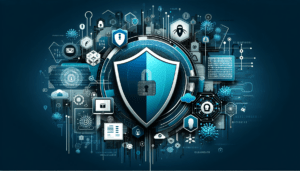Implementation of continuous risk management as standard practice
In 2021, organizations without zero-trust incurred an average breach cost of usd 1.76 million more than organizations with a mature zero-trust approach.1 Not surprisingly, 69% of organizations believe there will be an increase in cyber spending in 2022, compared with 55% in 2021, and over 25% expect double-digit growth in cyber budgets in 2022.2 With cyber-attacks on the rise due to widespread remote working and increased online interactions during the pandemic, it seems likely that this trend will only continue to grow.
Around 85% of breaches involved a human element in 2021. In addition, 36% of breaches involved phishing attacks, while ransomware attacks contributed to 10% of attacks. 3 In the midst of an ever-changing threat landscape, your top priority should be to ensure an advanced layer of cybersecurity that can protect your organization from malicious actors.
Building a solid defense isn’t easy, because cybersecurity isn’t a one-off exercise. Your business may be safe now, but could be in danger the very next minute. Securing your company’s critical data requires an unwavering commitment over the long term. While there are many pieces to this puzzle, the most important is ongoing risk management.
In this blog, we’ll guide you through cybersecurity risk assessment. By the end, we hope you’ll realize how installing cybersecurity solutions alone isn’t enough to counter cyberattacks, unless you make continuous risk management an operational standard for your business.
Understanding cybersecurity risk assessment
In rudimentary terms, cybersecurity risk assessment refers to the act of understanding, managing, controlling and mitigating cybersecurity risks across your organization’s entire infrastructure.
In its Cybersecurity Framework (CSF), the National Institute of Standards and Technology (NIST) states that the objective of cybersecurity risk assessments is “to identify, estimate, and prioritize risks to organizational operations, assets, individuals, other organizations, and the nation, resulting from the operation and use of information systems”.
The main purpose of a cybersecurity risk assessment is to help key decision-makers deal with current and imminent risks. Ideally, an assessment should answer the following questions:
- What are your company’s main IT assets?
- What type of data breach would have a major impact on your business?
- What threats are relevant to your company and its sources?
- What are the internal and external security vulnerabilities?
- What would be the impact if one of these vulnerabilities were exploited?
- How likely is it that a vulnerability will be exploited?
- What cyber attacks or security threats could impact your company’s ability to operate?
The answers to these questions will help you keep track of safety risks and mitigate them before disaster strikes. Now imagine periodically having the answers to these questions every time you sit down to make key business decisions. If you’re wondering how this would benefit you, read on.
Why make continuous risk management standard practice?
It’s essential to make continuous risk management an operational standard, especially in today’s cyberthreat landscape where even a single threat cannot be underestimated. In one study, 30% of respondents said that real-time threat intelligence is essential to their cyber risk management. 2 In one assessment, your business may seem to be on the right track, but in the next, you could spot vulnerabilities that can expose your corporate network to bad actors. This is precisely why having an ongoing risk management strategy is now an integral part of standard operations for every company.
Most organizations lack the ability to transform data into information for cyber risk assessment, threat modeling, scenario creation and predictive analysis. This under-utilization of data is one of the main obstacles to making continuous risk management an operational standard for companies.
Here are seven reasons why you simply can’t keep this key business decision on the back burner any longer:
Reason 1: Keep threats at bay
An ongoing risk management strategy will help you keep threats, both widespread and imminent, at a safe distance from your business.
Reason 2: Prevent data loss
The theft or loss of business-critical data can set your company back a long way, and your customers may turn to your competitors. Continuous risk management can help you stay alert to any possible attempt to compromise your company’s data.
Reason 3: Improved operational efficiency and reduced workforce frustration
As a business owner or key decision-maker in your organization, you’d be amazed at how constantly staying on top of potential cybersecurity threats can reduce the risk of unplanned downtime. The assurance that hard work won’t disappear into thin air will surely keep your employees’ morale high, reflecting positively on their productivity.
Reason 4: Long-term cost reduction
Identifying potential vulnerabilities and mitigating them in time can help you prevent or reduce security incidents, which in turn can save your company a significant amount of money and/or potential reputational damage.
Reason 5: An evaluation will set the right tone
You shouldn’t assume that there should be just one fixed template for all your future cybersecurity risk assessments. However, to keep them permanently up to date, you need to perform one first. Therefore, initial assessments will set the right tone for future assessments as part of your ongoing risk management strategy.
Reason 6: Improving organizational knowledge
Knowing the security vulnerabilities throughout your company will help you keep a close eye on the important areas your business needs to improve.
Reason 7: Avoid regulatory compliance problems
By ensuring that you have a formidable defense in place against cyber threats, you’ll automatically avoid the hassle when it comes to compliance with regulatory standards such as HIPAA, GDPR, PCI-DSS and so on.
Choose the right partner
Get the right partner to help you assess every cybersecurity risk your business is exposed to, and protect your business continuously over an extended period. Contact us to find out how we can help you mitigate cybersecurity issues through regular risk assessments.
1Cost of a data breach report, 2021






